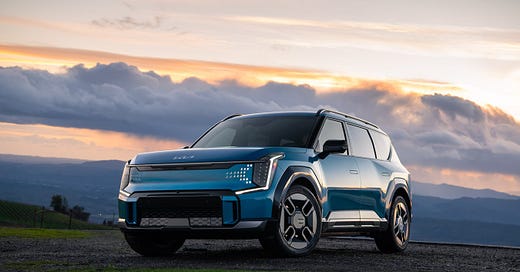
Even the most casual football fan tunes into Super Bowl Sunday. So the event seems ideal for automakers, who manufacture products that nine out of 10 Americans have access to, to promote their products.
This year, however, only two automakers shelled out money for Super Bowl ads — Jeep and Ram, both of which are owned by Stellantis. This is important because the Super Bowl has recently been a platform for showcasing not only new vehicles, but also electric vehicles: In 2022, seven commercials focused on electric vehicles.
But in the last three years, there have only been six EV-focused Super Bowl commercials.
And on Sunday, no commercial focused exclusively on EVs.
The lack EV commercials this year is alarming because, despite all their flaws, electric vehicles are necessary to transition to a greener future. And because purchasing power is one of our biggest tools to drive climate action, the Super Bowl — with its gross focus on consumerism — presents an excellent opportunity for automakers to shape our views of EVs and push us toward a cleaner way of driving.
Automakers’ hesitancy to promote EVs can be chalked up to several factors, from a shaky political environment to customers’ slow adoption of EVs to uncertainty over tariffs and subsidies.
Perhaps sensing these headwinds, Jeep’s Super Bowl commercial, though featuring an electric vehicle, was draped in a message about “freedom,” i.e., the freedom to choose what type of car you drive: “Freedom is the roar of one man’s engine, and the silence of another’s.”
(By this logic, freedom is also the freedom to pollute more, but no matter.)
At this point it’s good to highlight the obvious flaws of electric vehicles.
EVs are heavier than gas-powered vehicles, so they put more wear and tear on tires, shedding particles that pollute air and water.
Because 60% of the U.S. grid is powered by burning fossil fuels, charging an EV still emits climate pollution.
EVs, like cars in general, are expensive and out of reach for many consumers, putting a disproportionate burden on people with lower incomes.
The basic infrastructure that supports gas- and electric-powered vehicles is essentially the same, and car-centric infrastructure is dangerous, unhealthy, and boring.
EVs require rare metals that are typically extracted from countries in the Global South, triggering violence and pollution.
Of course, these flaws don’t mean we should still favor gas-powered vehicles over EVs — a common tactic of climate detractors is to point out the above as reasons to delay such a transition. And part of the reason we can’t delay this transition is that we simply do not have time.
Last month was the hottest January on record, and some scientists think we may have already passed the crucial 1.5-degree threshold outlined in the Paris Agreement.
In an ideal world, we would just create walkable, dense cities that eliminate the need for a car to get pretty much anywhere. But ideal worlds don’t exist. And if we’re going to drive everywhere, we might as well do so without burning fossil fuels.
Sammy Roth, writing for the Los Angeles Times, puts it like this:
“To maintain a habitable planet for ourselves and our children, we’ll need to make some compromises…. We’ll need to learn to live with exorbitantly wealthy investors raking in additional profits at our expense. We’ll need to elect some politicians whose ideas don’t fully line up with our own.”
And, as much as it pains me to say it, we’ll also need help from automakers. Unfortunately on Sunday, like Patrick Mahomes and the Chiefs, automakers failed to show up for the biggest game of the year.




The line “Freedom is the roar of one man’s engine” really stood out to me when I heard it. It speaks to a solipsistic conception of freedom—the roar of an engine is not freedom for those who have to listen to it outside the vehicle. This vision of “true” freedom as only “freedom to” but never “freedom from” is endemic in American culture, and is strikingly encapsulated by Jeep choosing to highlight one of the externalities of their cars as a selling point.